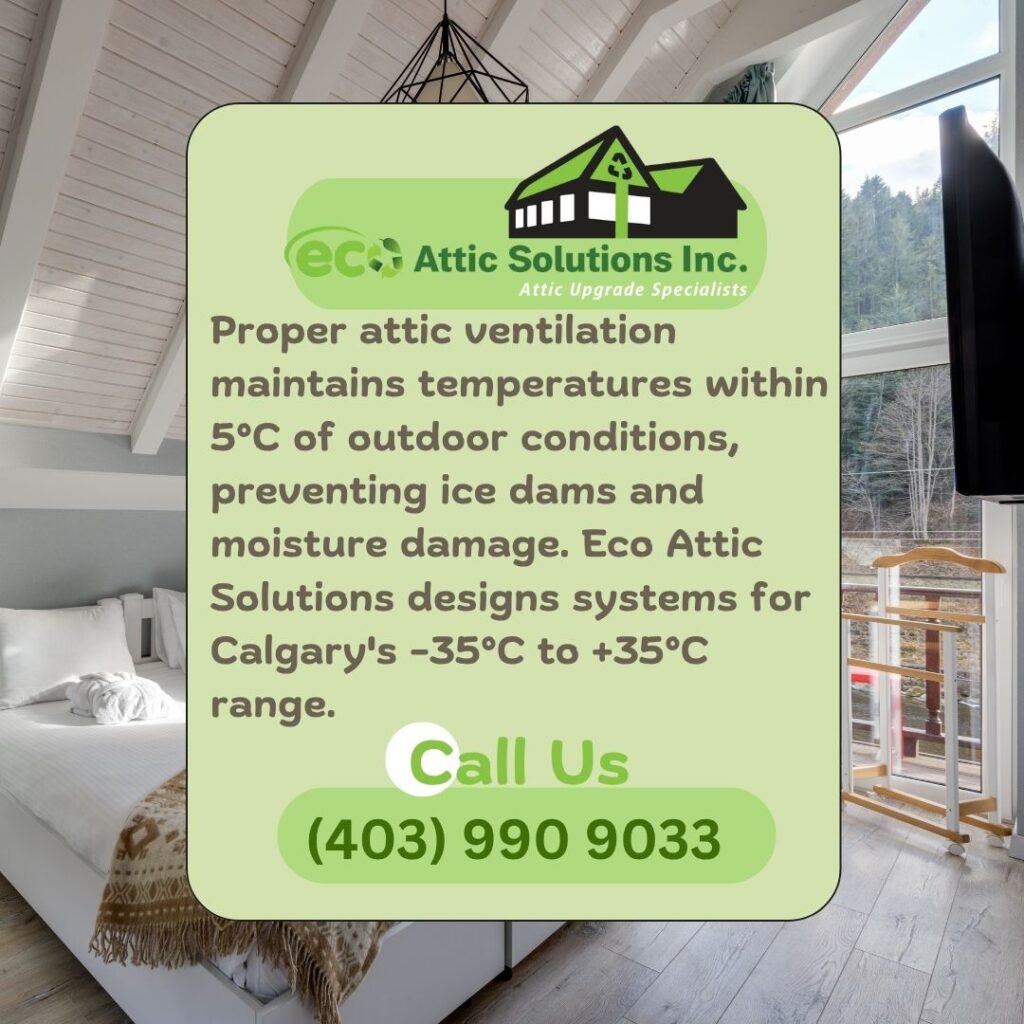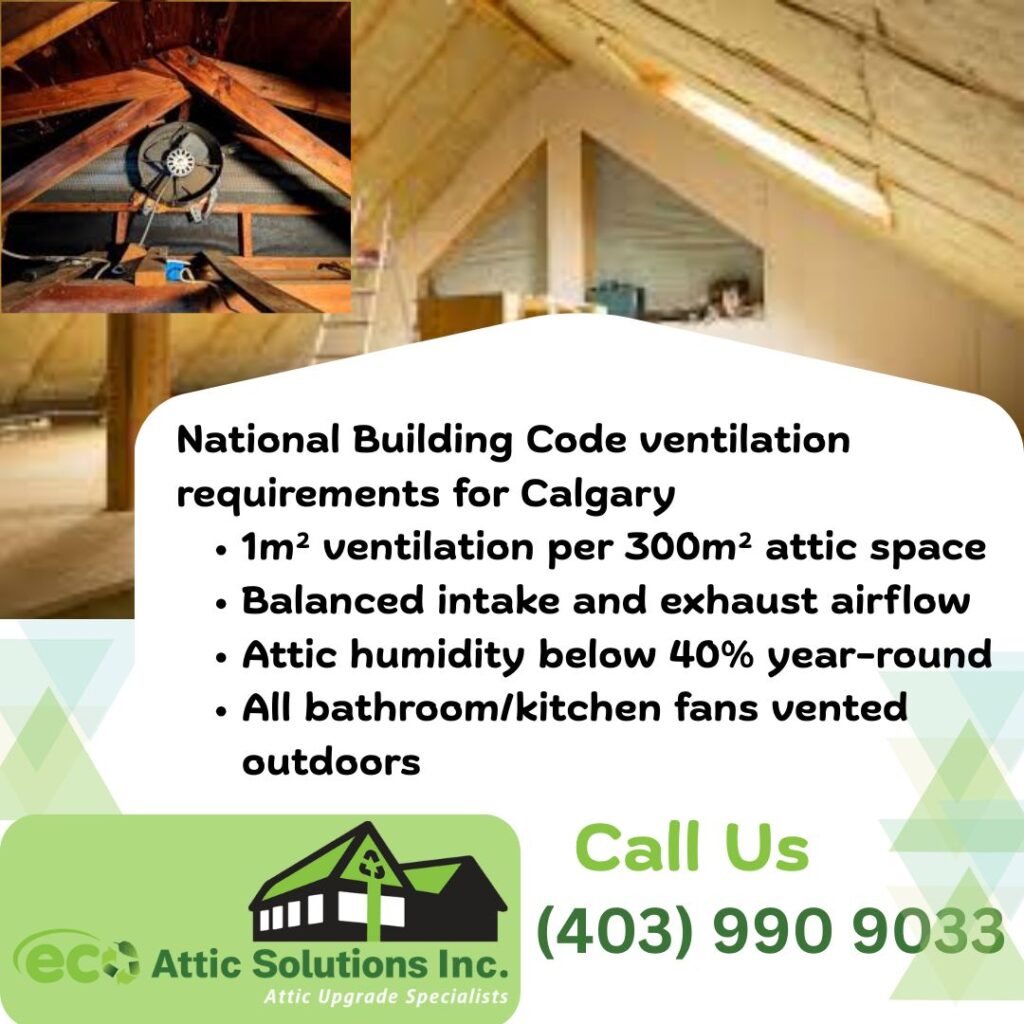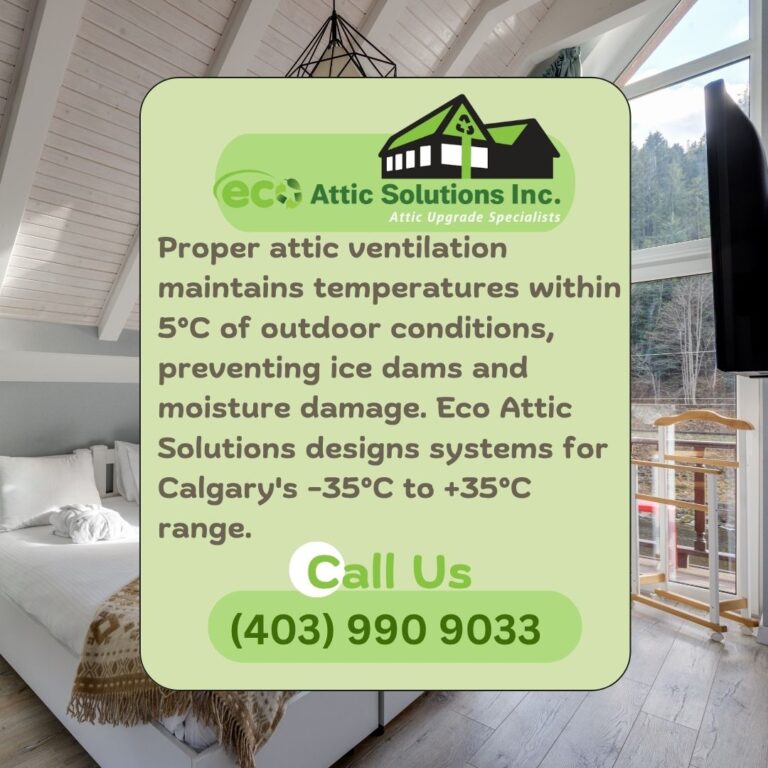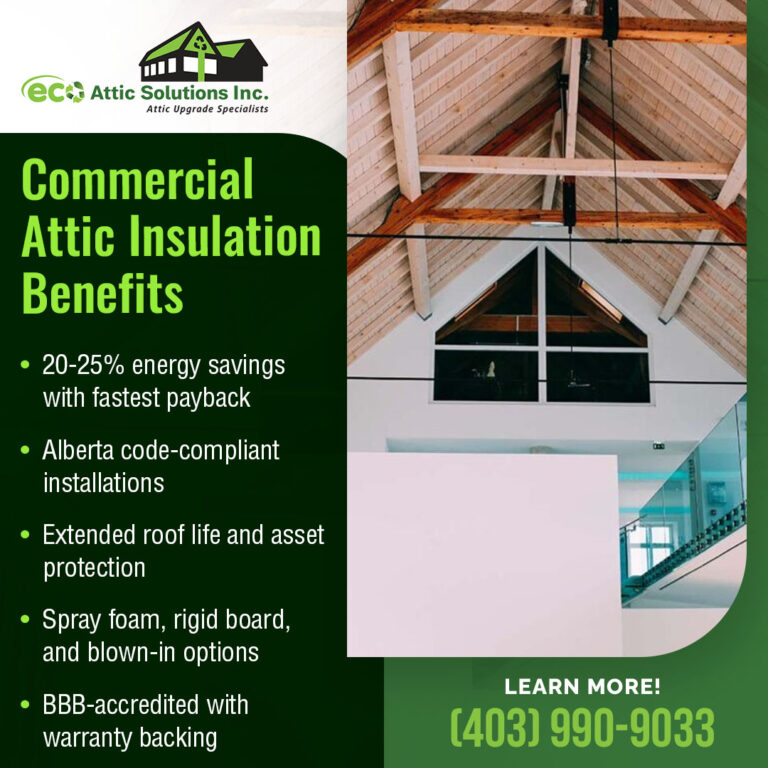Calgary’s commercial buildings face unique challenges from extreme weather patterns that can devastate unprepared structures. With temperature swings exceeding 40°C during chinook events and wind speeds reaching 120 km/h, commercial attic insulation in Calgary requires specialized expertise beyond typical residential approaches. At Eco Attic Solutions Inc., we’ve protected over 500 commercial properties across Alberta from costly weather-related damage.
Proper ventilation in commercial roofs serves multiple critical functions: preventing ice dam formation, controlling moisture accumulation, maintaining consistent indoor temperatures, and extending roof membrane lifespan. These systems must handle larger air volumes, accommodate mechanical equipment, and meet stricter building codes than residential properties.
The financial stakes are significant. For business owners managing warehouses, retail spaces, or office complexes, being aware of the ventilation requirements isn’t optional; it’s necessary for protecting your investment.

The Hidden Costs of Poor Commercial Ventilation
When commercial building ventilation fails, the impact extends far beyond the roofline. Operational disruptions, safety hazards, and costly repairs can all stem from a single preventable issue. One severe ice dam event, for instance, can halt business operations, damage inventory, and even expose property owners to liability claims from slip-and-fall incidents.
These costly failures usually trace back to three interconnected problems:
- Thermal bridging occurs when metal roof decking conducts interior heat directly to the roof surface, creating uneven snow melt patterns. This phenomenon intensifies in commercial structures due to their larger roof spans and metal construction materials. During Calgary’s frequent freeze-thaw cycles, meltwater refreezes at roof edges, forming massive ice dams that can exceed 1,000 kg per linear meter.
- Moisture accumulation presents another serious threat. Commercial buildings generate higher interior humidity from manufacturing processes, food service operations, and higher occupancy loads. Environment and Climate Change Canada reports that building designs in cities like Calgary must account for changing annual humidity levels, which affect long-term durability and performance.
- Energy waste is another significant concern. A study on energy benchmarking and ventilation-related energy-saving potentials found that improved ventilation management in industrial settings can lead to considerable reductions in energy consumption, operating costs, and greenhouse gas emissions. These findings highlight the importance of proper ventilation design and maintenance in minimizing long-term energy inefficiency across commercial buildings.
Commercial vs. Residential Ventilation Requirements
Roof insulation for commercial buildings demands fundamentally different approaches than residential systems. While homes typically use simple soffit-to-ridge airflow patterns, commercial structures require engineered solutions accounting for:
Building Code Compliance: The National Building Code of Canada mandates commercial buildings achieve ventilation ratios of 1:150 for low-slope roofs (under 4:12 pitch) when combined with vapour barriers. High-slope commercial roofs follow the 1:300 ratio but must accommodate rooftop HVAC units, skylights, and other penetrations.
Load Calculations: Commercial ventilation systems must handle:
- Process heat from manufacturing or kitchen operations
- Server room cooling requirements
- Variable occupancy patterns
- Equipment exhaust integration
These factors make professional ventilation design essential to ensure energy efficiency, code compliance, and long-term roof performance in commercial buildings.
Calgary’s Climate Impact on Commercial Roofs
No Canadian city challenges commercial roofing systems quite like Calgary. Our unique position, where prairie meets mountain, creates atmospheric conditions that standard ventilation designs cannot handle.
Chinook winds represent the most dramatic challenge. These warm, dry winds can raise temperatures by 30°C within hours, triggering rapid snow melt across large commercial roof surfaces. The resulting water volume overwhelms drainage systems designed for gradual melt.
Wind-driven rain and snow create additional complications. Calgary’s prevailing northwest winds drive moisture under roof membranes and into ventilation openings. Commercial buildings with large, flat expanses act like sails, creating negative pressure zones that pull moisture into roof assemblies.
Extreme temperature cycling tests every roofing component. Commercial roof membranes experience surface temperatures ranging from -40°C to +80°C annually. This 120°C temperature differential causes repeated expansion and contraction cycles that fatigue materials and compromise seals around penetrations.
Advanced Ventilation Systems for Commercial Applications
As a specialized commercial insulation contractor in Calgary, AB, we implement ventilation strategies tailored to each building’s unique requirements:
- Power ventilators provide consistent airflow regardless of wind conditions. Modern units feature variable-speed motors that adjust to temperature and humidity levels, maintaining proper conditions while minimizing energy consumption.
- Gravity ventilators work well for buildings with consistent internal heat generation. These units rely on temperature differential and stack effect to create natural airflow.
- Hybrid ventilation systems combine both passive and active components to maximize efficiency. In commercial applications, this approach may include pairing wind-driven turbines with thermostatically controlled power ventilators, ensuring adequate airflow during calm weather while taking advantage of Calgary’s frequent wind conditions.
- Smart ventilation controls represent the latest advancement in commercial insulation service. These systems monitor multiple parameters:
- Interior and exterior temperature differentials
- Relative humidity levels
- Barometric pressure changes
- Wind speed and direction
By analyzing these inputs, smart controls adjust ventilation rates while preventing over-ventilation during extreme weather events.
The Commercial Attic Rain Crisis
“Attic rain” poses particularly severe risks for commercial properties. When warm, moist air from business operations meets cold roof decking, frost accumulates rapidly across large surface areas. A single chinook event can melt this frost simultaneously, creating torrential water flow inside the building.
Common contributing factors in commercial settings include:
- Unsealed penetrations around HVAC ducts
- Inadequate vapour barriers at wall-ceiling junctions
- Bathroom and kitchen exhaust fans venting into attic spaces
- Insufficient ventilation capacity for the building size
Preventing commercial attic rain requires extensive solutions, such as:
- Air barrier installation at all ceiling penetrations
- Proper exhaust routing for all mechanical systems
- Balanced ventilation maintaining a slight positive pressure
- Continuous monitoring with moisture sensors and alerts
Professional Assessment and Installation Process
Eco Attic Solutions follows a systematic approach for commercial attic insulation in Calgary, projects:
Phase 1: Complete Building Analysis
Our certified technicians conduct detailed analysis, including:
- Thermal imaging of the entire roof surface
- Air leakage testing with smoke generators
- Moisture mapping using professional meters
- Ventilation capacity calculations
- Historical utility usage analysis
Phase 2: Custom Design Development
We engineer solutions specific to your building’s needs:
- CFD modelling for complex roof geometries
- Integration with existing mechanical systems
- Code compliance verification
- ROI projections with payback timelines
Phase 3: Professional Installation
Our crews implement upgrades with minimal business disruption:
- Off-hours installation scheduling
- Protective coverings for inventory/equipment
- Continuous air quality monitoring
- Daily progress reporting
Phase 4: Performance Verification
Post-installation testing confirms system effectiveness:
- Blower door testing to verify air sealing
- Thermographic inspection of insulation coverage
- Ventilation flow rate measurements
- Moisture level baseline establishment
Maintenance Programs for Long-Term Performance
Commercial roof systems require ongoing attention to maintain peak performance. At Eco Attic Solutions, we offer thorough maintenance programs that protect your investment:
Quarterly Inspections
- Ventilation inlet and outlet cleaning
- Moisture sensor calibration
- Insulation settling assessment
- Seal integrity verification around penetrations
Seasonal Preparations
- Pre-winter ice dam prevention treatments
- Spring drainage system clearing
- Summer cooling efficiency optimization
- Fall weatherproofing updates
Emergency Response
- 24/7 monitoring for critical facilities
- 4-hour response time for urgent issues
- Temporary remediation to prevent business interruption
- Insurance claim documentation support
Return on Investment for Commercial Properties
Investing in proper attic insulation and ventilation for commercial buildings can yield measurable long-term benefits across several key areas:
- Energy Efficiency: Well-designed insulation and ventilation systems help reduce heating and cooling demands by improving thermal performance. This contributes to lower utility costs and a more stable indoor environment throughout Calgary’s extreme seasonal temperature swings.
- Roof Longevity: Adequate ventilation helps regulate attic temperature and moisture, reducing stress on roofing materials. Over time, this can support longer roof service life and minimize the frequency of costly repairs or replacements.
- Insurance and Risk Management: Buildings that demonstrate strong energy efficiency and moisture control measures may qualify for favourable insurance considerations. Consistent maintenance and documentation of building performance can also support smoother claim processes in the event of damage.
- Workplace Comfort and Productivity: Maintaining consistent indoor temperatures and air quality can improve occupant comfort. Stable environmental conditions support healthier working environments, potentially enhancing employee satisfaction and operational consistency.
Common Mistakes in Commercial Installations
Through inspecting hundreds of commercial properties, we’ve identified recurring errors that compromise system performance:
- Undersized ventilation remains the most frequent problem. Many contractors simply scale up residential calculations without accounting for commercial heat loads, equipment exhaust, and occupancy variations. This results in systems operating at maximum capacity continuously, leading to premature failure.
- Mixing incompatible components creates airflow conflicts. We often find buildings with both gravity and power ventilators installed haphazardly, causing short-circuiting where exhaust air immediately re-enters through nearby intakes.
- Ignoring vapour barriers proves especially costly in Calgary’s climate. Commercial buildings generate substantial interior moisture that must be prevented from entering roof assemblies. Incomplete or damaged vapour barriers allow moisture infiltration that ventilation alone cannot overcome.
- Inadequate intake ventilation starves exhaust systems of replacement air. This creates negative building pressure that pulls unconditioned air through every available opening, increasing heating costs and allowing moisture infiltration.
Industry Standards and Certifications
Eco Attic Solutions maintains certifications verifying quality commercial attic insulation service delivery. We stay current with evolving standards through continuous education and industry participation. Our team members bring extensive commercial insulation service experience, supported by specialized training tailored to Calgary’s demanding climate conditions.
Technology Integration for Modern Buildings
Modern commercial buildings increasingly incorporate smart technologies to enhance energy efficiency and system reliability.
- Building Automation Systems (BAS) enable centralized control and monitoring of ventilation components. These systems can adjust airflow based on occupancy patterns, weather conditions, and energy pricing signals.
- IoT Sensors installed throughout roof assemblies collect real-time performance data, monitoring factors such as temperature, humidity, and airflow. This information allows facility managers to identify potential issues early and maintain optimum indoor conditions.
- Predictive Analytics tools analyze historical data to refine ventilation strategies. By applying machine learning algorithms, these systems can detect performance trends and support data-driven decision-making for long-term building efficiency.
Eco Attic Solutions continually explores emerging technologies and best practices to enhance how ventilation and insulation systems are designed, installed, and maintained, ensuring each solution aligns with evolving industry standards and the unique demands of Calgary’s climate.

Your Expert Commercial Insulation Contractor in Calgary
Protecting your commercial property from Calgary’s extreme weather requires more than basic ventilation; it demands engineered solutions from experienced professionals. As your dedicated commercial attic insulation contractor in Calgary, AB, Eco Attic Solutions combines decades of local expertise with modern technology to deliver systems that perform reliably through every weather challenge.
Our thorough approach addresses every aspect of commercial roof performance, from initial evaluation through ongoing maintenance. We understand that your building represents a significant investment, and we’re committed to protecting it with solutions that deliver measurable returns.
Don’t wait for the next Chinook or severe weather event to expose vulnerabilities in your commercial roofing system. Contact our team at Eco Attic Solutions today at (403) 990-9033 or admin@ecoatticsolutions.com to schedule your professional commercial roof analysis. Let us show you how proper ventilation and roof insulation for commercial buildings can enhance performance, efficiency, and long-term protection for your investment.




